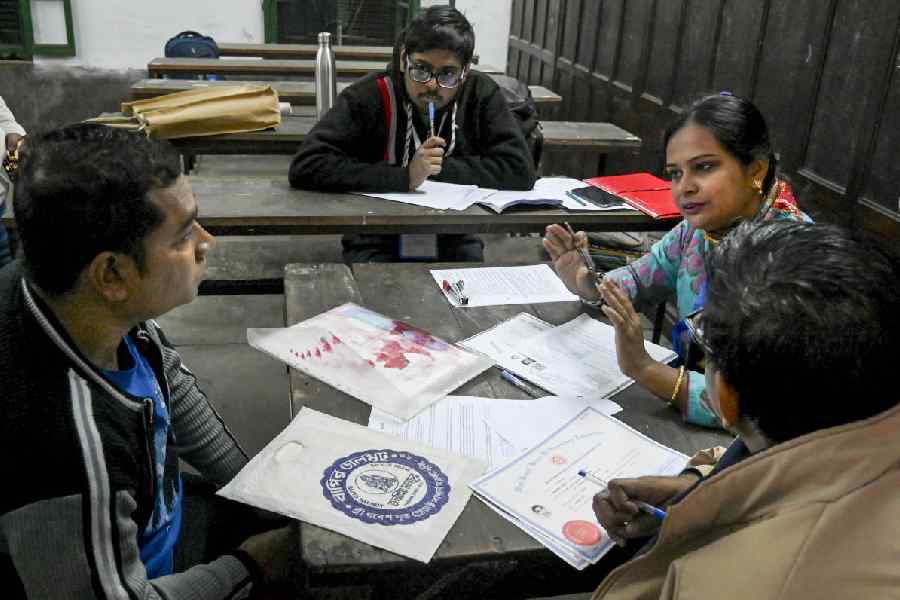Dancers standing on earthen pots, balancing bottles on their heads; dancers dressed in leaves and camouflage paint; a chorus of war cries accompanied a vigorous dance performed to send troops out to battle.... Lucky was the audience at EZCC that got to witness nearly 20 folk groups from the interiors of east and northeast India, each presenting their endangered art forms.
“This two-day stage show was part of our Guru Shishya Parampara Scheme 2022-2024,” said EZCC assistant director Tapas Samantaray. “India’s soul lies in its villages, rich with music, dance, art and craft, but why should access be restricted to villagers? So we selected 20 gurus of dying arts and arranged for them to teach the next generation. We are also documenting these arts through books and videos.”
This project is an ongoing one, that started in 2004, where EZCC financially supports the gurus, their assistants, and about eight students every month while it lasts.
But Samantaray stressed that the greatest support in this endeavour would come from the audience. “It is your interest that will ultimately save our heritage,” he said, before throwing the stage open.
Strength in tradition
The artistes were as like as chalk and cheese. The shikari nritya dancers looked like they had stepped out of the jungle, carrying bows, donning wigs, and clad in leaves. One even wore a tiger costume.
“This dance is performed by those living at the base of Jharkhand’s hilly forests. It is traditionally performed by hunters celebrating a successful hunt,” said guru Ghashiram Mahto, who had brought his students along. “But the dance is fading away back home and cannot be performed without serious training.”
Manoranjan Ojha, guru of Bhojpuri folk music observed that any form of development today is used as an excuse to forget traditions, even to look down on them, thinking modernity is superior. “All our women once knew these songs, but now no one has the time or inclination to learn. They simply hire professionals to sing at festivals.”
Guru Laxmi Prasad Yadav of Bihar said skilled teachers were important in preserving dying arts. “When I was young, there were no teachers for bhure godhin music, nor were the lyrics documented anywhere. My village was my university. But with the authorities now supporting the guru-shishya parampara, I can pass on my knowledge to others, ensuring that this art form continues beyond my lifetime,” he said.
War zone
Ghumura is a martial dance from Odisha, performed by groups of about 15 men. It is sung and danced to evoke the spirit of battle and is a prominent feature of Dussera, symbolising the victory of good over evil. “Our dancers are clad in dhotis, shell jewellery, and elaborate headgear made of tall peacock feathers. And their handmade leather drums are tied at their waists and thighs to play on the move,” said guru Kailash Singh.
Then there were the arida pala sankirtan eshei singers from Manipur, a state that is embroiled in conflict. “Yes, there is tension, but only in pockets. I belong to the Meitei community living in a Meitei area, so I’m safe, and there were no issues coming here,” said guru A. Sobhachandra Singh. “Life goes on despite the strife — students are still coming for classes and we continue to be invited for shows, where we are singing songs praying for peace.”
Their male dancers wore imposing white headgear called kokyet, while the women, dressed in contrasting colours, created a rhythmic clashing of cymbals as they together spun tales of the Raas Lila.
Sight to behold
Rashmita Misra and her friends looked exotic in knee-length saris, tribal anklets, and body art across their faces, shoulders, and arms. “We bring you dhaap nritya, performed at all celebrations in Odisha, especially weddings,” said the student of Mohit Swain.
One of the most entertaining performances was the hajong from Assam. Men and women started in two rows but gradually merged into circles, clapping, twirling, and waving colourful handkerchiefs. “This dance can involve anywhere from 10 to 200 participants, as it is meant to include everyone watching,” said guru Babash Hajong, with a smile.
Sikkim’s lakhey featured dancers performing in massive masks and wigs, somewhat reminiscent of chhou. “The masks are heavy, about 5-8 kg, so only men perform this dance. But these days they are made of fibre, which is still way lighter than the original metal masks that used to weigh nearly 50 kg,” said guru Chabilal Pradhan.
Another complex dance was Tripura’s hojagiri, which had women displaying remarkable balance. “We fill pots with sand, and the girls stand on them and dance while balancing wicker baskets and wooden bottles on their heads,” explained guru Rajendra Reang.











